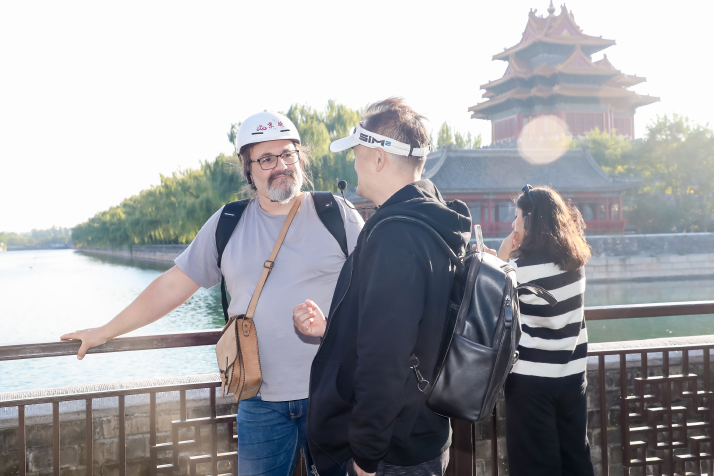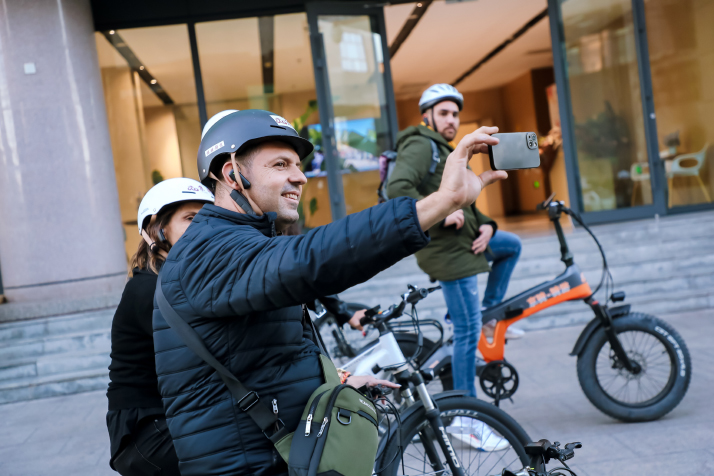| Lifestyle |
| Chinese tour guides design new ways to elevate inbound tourism | |
|
|
|
With China's expanded visa-free policies, overseas tourists are showing an increased interest in visiting the country. In the first quarter (Q1) of this year, the number of inbound visits had reached 58.2 percent of that in the same (pre-pandemic) period of 2019, according to the China Inbound Tourism Development Report (2023-24) issued by the China Tourism Academy on June 25.
During the May Day holiday, from May 1 to 5 this year, the number of inbound tourists in China reached 1.775 million, according to the Ministry of Culture and Tourism (MCT). In response to this influx of inbound tourists, Chinese tourism professionals are poised to innovate travel offerings and fine-tune their services to showcase China's openness and verve. Also in Q1, Beijing emerged as a major inbound tourism destination with 469,000 inbound tourists, reaching 67.2 percent of the 2019 level, according to statistics from the Beijing Municipal Bureau of Culture and Tourism. A capital city with a history spanning over 3,000 years, Beijing is a place where antiquity and modernity blend. How can a city like this lift its ability to receive inbound tourists? A new route David Dou, co-founder of JingQi, a company focusing on "cycling plus cultural travel services," is also an English-language tour guide. He is a "gold medal tour guide" certified by the MCT. Over his more than two decades in the industry, Dou has been exploring travel services favored by tourists from other countries, integrating traditional Chinese culture into inbound tourism products. "China's older generations prefer to make travel plans and visit famous attractions one after another. But based on my observations in recent years, younger generations and international tourists like how 'the unexpected' unfolds along the journey and focus on in-depth experiences when traveling," Dou told Beijing Review. Dou recalled the process of creating his first cultural tourism product. He has been working as a foreign-language tour guide since graduating from university. "I was one of the editors of the Training Manual for English-speaking Tour Guides. I edited the chapter about the Beijing Central Axis, a north-south line adorned with cultural relics and historic buildings," Dou said. "Stretching 7.8 km, the Central Axis has witnessed the history of China since the 13th century. It extends from the Bell and Drum towers in the north to the Yongding Gate in the south. Landmarks, including the Forbidden City, also known as the Palace Museum, Tian'anmen Square and the Temple of Heaven, are located on or alongside the axis," he elaborated. Dou has always wanted to present the greatness of the Central Axis to international visitors in a comprehensive fashion. However, one challenge he faced was transportation, given the long distances and the impossibility of driving deep into Beijing's intricate network of hutongs, or traditional narrow alleyways. Then he came across electric bicycles and realized they were the ideal solution. This inspired Dou to pioneer the "cycling plus cultural travel" experience. "I define bicycle tours as the third travel mode, the first one being a group tour and the second a self-driving tour. Neither of the first two can allow tourists to get as deeply into the city [of Beijing] as cycling." Dou and his team spent two weeks cycling along the Central Axis, meticulously inspecting every scenic spot and carefully noting the details visible along the hutongs' twists and turns. Their goal was to craft an ideal route tailored to these observations.  David Dou (center) explains the cultural significance of the Forbidden City's Corner Towers to an international visitor during a cycling tour in October 2023 (COURTESY PHOTO)
For Dou, crafting a cycling route is akin to mastering the "art of balance." "Bicycle tours allow tourists to switch the focus between movement and stillness. While cycling, the environment is changing dynamically, so when planning an itinerary, I specifically pay attention to the combination of movement and stillness to create a pleasant rhythm. In other words, there needs to be a reasonable combination of riding time, resting time and sightseeing time."
Hop on "In the past, many traditional tourism products lumped together different scenic spots simply because they were close. Designing an itinerary this way certainly saves time and money, but that is not what I value," Dou said. What he highlights in his cycling tourism products is culture. "When I plan a route, the distance between attractions doesn't matter. What matter to me are the cultural or narrative connection and how to provide my tourists with an immersive experience. I hope that when cycling along the route I designed, participants can feel like they are in a scroll that is slowly unfolding—different attractions all set in the same context," he explained. But this does place higher demands on tour planners. "We must dig deep to uncover and study the historical stories and cultural elements behind each attraction to connect them and truly form a cultural tourism route," Dou said.  Overseas tourists take a Peking Opera cultural tour organized by JingQi in October 2023 (COURTESY PHOTO)
Plus, tour guides' language skills greatly matter. Due to the disparity in cultural background, it is challenging for international tourists to promptly grasp the history and culture of each site during the tour. "I have always been very attentive to improving my English proficiency. Meanwhile, I try to introduce traditional Chinese culture simplistically through storytelling. Now, we have assembled over 40 foreign-language guides, including English, Spanish, French and Japanese tour guides," he continued. In addition to the Central Axis, Dou and his team have launched cycling products such as the Peking Opera cultural tour, Shougang Park tour and Grand Canal tour based on Beijing's urban characteristics and specific road conditions. Currently, these cycling routes are fully booked until the end of the year. In the future, Dou hopes to change the existing mold of tour guide training. "I want to train more guides who can truly mobilize and lead international tourists during immersive urban cultural trips, rather than guides only giving rigid, formal explanations at designated sites," he said. Dou's team is now ready to work with more travel agencies to promote their tourism model to other cities in China and "assist the development of inbound tourism," as he put it. (Print Edition Title: Cycle Scenic Splendor) Copyedited by Elsbeth van Paridon Comments to kangcaiqi@cicgamericas.com |
|
||||||||||||||||||||||||||||||
|